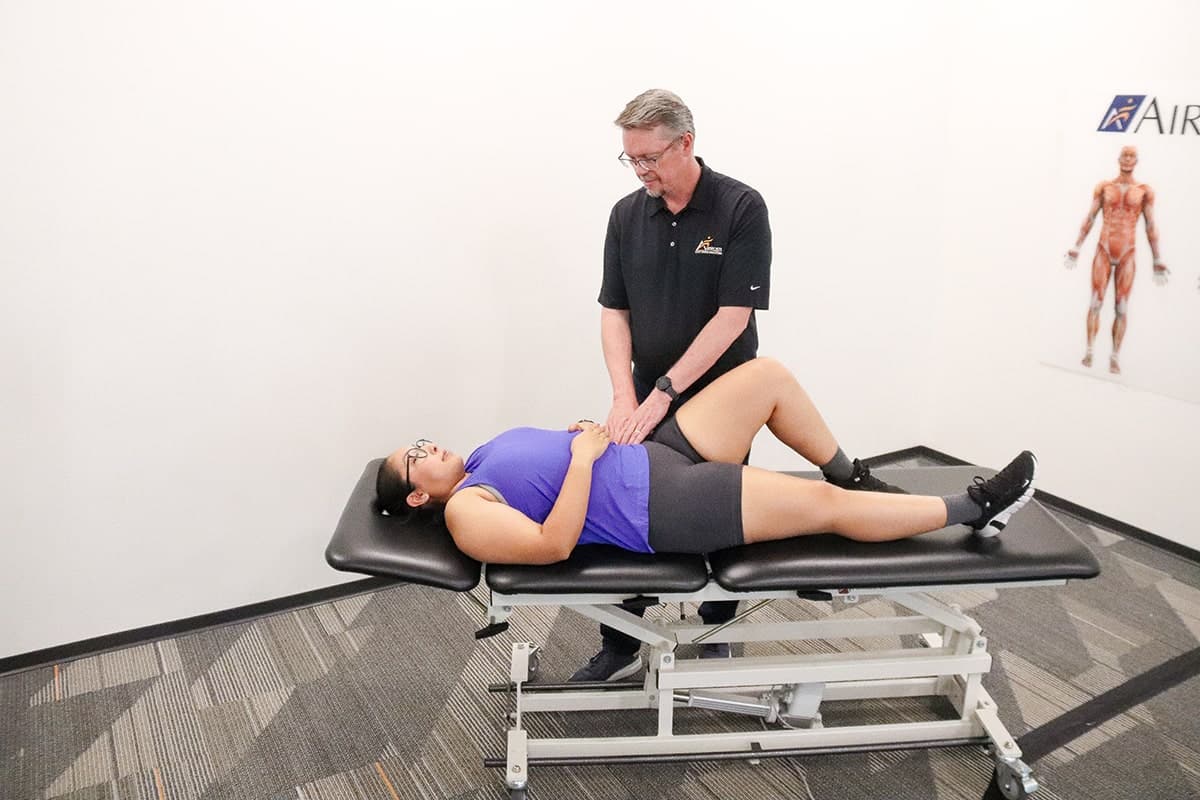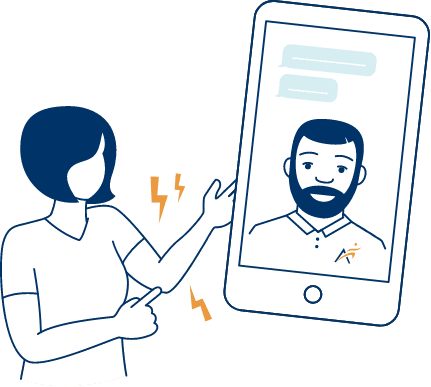(21,000+ reviews on Google across 150+ locations)

Have questions or would like to schedule over the phone? Call us at 844-719-5079
Find an Airrosti Clinic Near You (OH, TX, VA, WA)
We take the time needed for a thorough examination to find the underlying cause of your pain.
Airrosti Providers use hands-on manual therapy to treat your specific hip injury to reduce pain, increase mobility, and accelerate healing.
No surgery, injections, or prescription medication.
Patients have shorter recovery time with an average of 3.2 visits over 2 weeks.
Speed your recovery and keep your pain from returning.

Hip pain and stiffness is a common condition treated at Airrosti. The hip is one of the largest joints in the body. To function correctly and with full range of motion, the ligaments, muscles, and fascia surrounding the joint must be working in unison. To know how to best treat hip pain, you should understand how it occurs, what symptoms to look out for, and what kind of treatment may be best for you.
Still have questions or concerns about your hip pain? Schedule a no-cost video chat with one of our Providers.
The hip joint is designed to withstand repeated motion and a fair amount of wear and tear. This ball-and-socket joint allows for fluid lower body movements. While many causes of hip pain can arise from the joint itself, there are numerous structures surrounding the hip that can also be the source of pain.
Untreated acute trauma is often the cause of hip pain, but any source of inflammation may cause discomfort in the hip area. Pain is one of the symptoms of inflammation, along with swelling, warmth, and redness; together these are signals and symptoms that a problem may exist.
Aside from an acute injury, some other causes include overuse injuries in which muscles, tendons, and ligaments can become inflamed. Overuse of the hip can also wear away the cartilage in the hip joint, causing arthritis. Common hip problems caused by strain and overuse include hip tendonitis/tendinitis, hip bursitis, and hip flexor strain.
You may also experience referred pain from other structures outside the hip joint. This means that, while the hip hurts, the problem may originate elsewhere, such as Snapping Hip Syndrome being actually being caused by the iliotibial band.
Depending on the condition that’s causing your hip pain, you may feel discomfort in various parts of your body, including:
• In the upper thigh
• Inside or outside of the hip joint
• Around the groin
• Around the buttocks
• In the low back
Signs of an inflammatory condition like tendonitis or bursitis often include:
• Reduced range of motion in the hips
• Tenderness and swelling
• Stiffness in the hip muscles and joints
• Increased pain when pressure is added to the affected area
• Increased fatigue during physical activity
• Pain may be worse at night, when lying on the affected hip, when you move your hip, and when getting up from a seated position
Surgery is not always necessary for hip pain. In many cases, conservative treatments such as rest, physical therapy, Airrosti care, medication, and lifestyle modifications can effectively manage symptoms and improve hip function. Surgery may be considered if conservative treatments fail to provide relief, or if there is evidence of severe damage to the hip joint such as arthritis, labral tears, or a fracture.
It’s generally safe to take medications for hip pain, but it’s important to use them as directed by your healthcare provider. Over-the-counter pain relievers such as acetaminophen or nonsteroidal anti-inflammatory drugs (NSAIDs) can help reduce inflammation and alleviate discomfort. Prescription medications such as muscle relaxants or corticosteroid injections may be recommended for more severe cases of hip pain. It’s important to consult with a healthcare professional before starting any new medication regimen, especially if you have underlying health conditions or are taking other medications.
Yes, there are several self-care techniques and exercises that can help alleviate hip pain. These may include gentle stretching exercises to improve flexibility, strengthening exercises to stabilize the hip joint, and low-impact activities such as swimming or cycling to maintain mobility and reduce stress on the hip. Additionally, applying ice or heat to the affected area, and maintaining a healthy weight can also help alleviate hip pain.
While it’s important to avoid activities that exacerbate hip pain, completely restricting all activity may not be necessary. Modifying activities to reduce strain on the hip joint and incorporating rest breaks can help alleviate symptoms. Low-impact exercises such as walking or gentle yoga can be beneficial for maintaining mobility and promoting healing. However, if hip pain persists or worsens with activity, it’s important to consult with a healthcare professional for proper evaluation and guidance on activity modification.
I had surgery to repair a labral tear in my left hip and consequently had to use my right leg for support for weeks. The source of my pain wasn't addressed during post-op physical therapy, so I decided to make an Airrosti appointment. I have used Airrosti before for lower back pain and was hopeful for positive results with this issue. Dr. Garza was very professional, and personable/easy to talk to, especially during the sometimes painful treatment process. During every visit, Dr. Garza thoroughly explained the treatment plan for that day and going forward. My pain level improved pretty much on the planned timeline Dr. Garza set out for me. I am pain-free and so thankful for his help to get me there! Having this level of excellence in car...+ show moree is wonderful AND to be able to visit an Airrosti clinic downtown is invaluable.
by Marsha Perez
We offer both in-clinic and telehealth appointments to best suit your needs.
Reviewed by Casey Crisp, Doctor of Chiropractic
Disclaimer: Always consult with your doctor before starting any exercise program. If you experience any numbness, tingling or reproduction of your symptoms, please contact your doctor.
